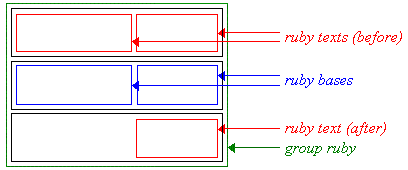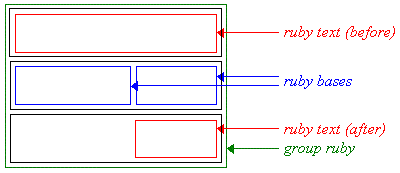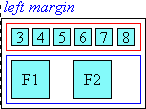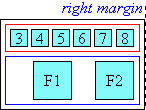This document proposes a set of CSS properties associated with the 'Ruby'
elements.
This document is a working draft of the CSS Working Group which is part of
the Style activity. It contains a
proposal for features to be included in CSS level 3.
Feedback is very much welcomed. Comments can be sent directly to the
editor, but the mailing list www-style@w3.org (see
instructions) is also open and is
preferred for discussion of this and other drafts in the Style area.
This working draft may be updated, replaced or rendered obsolete by other
W3C documents at any time. It is inappropriate to use W3C Working Drafts as
reference material or to cite them as other than "work in progress". Its
publication does not imply endorsement by the W3C membership or the CSS Working Group (members only).
A previous version of the material in this working draft was published as
Chapter 7
of International Layout
(W3C Working Draft 10 Sept. 1999, http://www.w3.org/TR/1999/WD-i18n-format-19990910/).
To find the latest version of this working draft, please follow the "Latest
version" link above, or visit the list of W3C Technical Reports.
This CSS3 module depends on the following other CSS3 modules:
- TBD (but will include the module describing 'writing-mode')
It has non-normative (informative) references to the following other CSS3
modules:
There is a number of illustrations in this document for which the following
legend is used:
 - wide-cell glyph (e.g. Han)
which is the n-th character in the text run, they may also appear as
half size boxes when used as annotations.
- wide-cell glyph (e.g. Han)
which is the n-th character in the text run, they may also appear as
half size boxes when used as annotations.
 - narrow-cell glyph (e.g. Roman)
which is the n-th glyph in the text run.
- narrow-cell glyph (e.g. Roman)
which is the n-th glyph in the text run.
Many typographical properties in East Asian typography depend on the fact
that a character is typically rendered as either a wide or narrow character.
All characters described by the Unicode Standard can be categorized by a width
property. This is covered by a Unicode Technical report (TR#11) available from
the Unicode Web site.
The orientation which the above symbols assume in the diagrams corresponds
to the orientation that the glyphs they represent are intended to assume when
rendered in the UA. Spacing between these characters in the diagrams is
usually symbolic, unless intentionally changed to make a point.
"Ruby" is the commonly used name for a run of text that appears in the
immediate vicinity of another run of text, referred to as the "base", and
serves as an annotation or a pronunciation guide associated with that run of
text. Ruby, as used in Japanese, is described in JIS X-4051 [JIS]. The ruby structure and the HTML markup to represent it
is described in the Ruby specification [RUBY]. This
section describes the CSS properties relevant to ruby. The following figures
show two examples of Ruby.
In the second example, multiple annotations are attached to a base
sequence, the hiragana characters on top refer to the pronunciation of the
base Kanji characters, while the word 'University' on the bottom is an
annotation describing the English translation of the two last Kanji characters
of the base. The two examples correspond respectively to two types of ruby: a
simple ruby using a simple ruby markup and a complex ruby using a complex ruby
markup.
In a UA that supports ruby, the ruby structure consists of three or more
boxes. The outermost container is the ruby element itself.
In the simple case, it is a container for two non-overlapping boxes: the ruby
text box (rt element)
and the ruby base box (rb element). The
positioning of these two boxes relative to each other is controlled by the 'ruby-position' property.
In the case of complex ruby, the ruby element is a container for two or
three non-overlapping boxes: one ruby base collection (rbc element), and one
or two ruby text collections (rtc element). The
rbc element is itself a container for one or several ruby base
box (rb element), while each rtc element is a
container for one or several ruby text box (rt element). The position of the
rtc element in relation to the related rbc element
is controlled by the 'ruby-position' property. The two
following figures show examples of these complex ruby.
In the example above, the rtc element following the
rbc element contains two rt elements with the first one
being empty, the empty rt element corresponds to the first part
of the ruby base collection (identified by the first rb element
within the rbc element)
In the example above, the rtc element preceding the
rbc element spans the whole ruby base collection. The following
rtc element still contain two rt elements, one of
which is empty. The spanning behavior of rt text elements is
controlled by the rbspan attribute in a
way similar to the colspan attribute used for table column.
The width of the ruby box is by default determined by its widest child
element, whose width in turn is determined by its content. All ruby's direct
children assume the width of the widest one of them. In this respect, the ruby
box is much like a two or three row table element, with the
following exceptions:
- the ruby box is an inline element, like an image, even though it itself,
like a table, is a container of other boxes
- the equivalent of the cells: the rb element and the
rt text element can only contain inline-level elements. This
also means that a ruby element cannot be embedded into another ruby
element.
- the content of each 'cell' is always measured at its maximum width
- unlike a table, a ruby element doesn't have to fit in a line, the ruby
box may be split into several boxes at line boundary, depending of the
spanning of the ruby texts. This is however only possible for the complex
ruby and can only happen at the boundary of non spanning elements.
- both the ruby text and the ruby base boxes may overlap with adjacent
text (outside of the ruby element) if an appropriate 'ruby-overhang' parameter is set via CSS. Note
however that the actual content of the ruby base cannot overlap with that
adjacent text. The distribution of the content of the ruby base within the
ruby base box is controlled by the 'ruby-align'
property.
If the ruby text is not allowed to overhang, then the ruby behaves like a
traditional box, i.e. only its contents are rendered within its boundaries and
adjacent elements do not cross the box boundary:
However, if ruby text is allowed to overhang adjacent elements and it
happens to be wider than its base, then the adjacent content is partially
rendered within the area of the ruby base box, while the ruby text may be
partially overlapping with the upper blank parts of the adjacent content:
The ruby text related to a ruby base can never overhang another ruby
base.
The alignment of the contents of the base or the ruby text is not affected
by the overhanging behavior. The alignment is achieved the same way regardless
of the overhang behavior setting and it is computed before the space available
for overlap is determined. It is controlled by the 'ruby-align' property.
The exact circumstances in which the ruby text will overhang other
elements, and to what degree it will do so, will be controlled by the 'ruby-overhang' property.
This entire logic applies the same way in vertical ideographic layout, only
the dimension in which it works in such a layout is vertical, instead of
horizontal.
For a line box containing one or several ruby elements the line height is
first determined without considering the ruby text elements, i.e. only the
ruby base element line height is considered.
If the resulting half-leading values are zero or not large enough to fit
the ruby text elements, the half-leading values are increased until these ruby
text elements can be fitted into their respective half-leading. Only the
half-leading corresponding to the ruby text element to be inserted is
increased, the other half-leading is left unchanged from the original computed
line height. If both half-leading have ruby text elements, both may be
adjusted.
This mechanism allows rendering of evenly spaced lines of text within a
block-level element, whether a line contains ruby or not. The authors need
only to set for the block-level element a line height value larger than the
computed line-height of the larger ruby element within the block.
The same principle applies to the grid layout. Basically, the whole ruby
element needs to be considered for sizing purpose, but for alignment purpose,
only the ruby base is taken into account.
- 'ruby-position'
-
| Value: |
before | after | right | inline | inherit |
| Initial: |
before |
| Applies to: |
the parent of elements with display: ruby-text. |
| Inherited: |
yes |
| Percentages: |
N/A |
| Media: |
visual |
This property is used by the parent of elements with display: ruby-text to
control the position of the ruby text with respect to its base. Such parents
are typically either the ruby element itself (simple ruby) or the
rtc element (complex ruby). Possible values:
- before
- The ruby text appears before the base. This is the most common setting
used in ideographic East Asian writing systems. This is the initial
value.
If the base appears in a vertical-ideographic layout mode, the ruby
appears on the right side of the base and is rendered in the same layout
mode as the base (i.e. vertical-ideographic).
Note the special case of traditional Chinese as used especially in
Taiwan: ruby (made of Bopomofo glyphs) in that context can appear along
the right side of the base glyph, as if the text were in vertical
layout, but the bases themselves are rendered on a horizontal line,
since the actual layout is horizontal:
In order to achieve that effect, vertical-ideographic layout should
be set on each individual ruby. That can be accomplished with the
following simple CSS rule:
ruby.bopomofo { writing-mode: tb-rl }
- after
- The ruby text appears after the base. This is a relatively rare
setting used in ideographic East Asian writing systems, most easily
found in educational text.
If the base appears in a vertical ideographic mode, the bottom ruby
appears on the left side of the base and is rendered in the same layout
mode as the base (i.e. vertical).
- right
- The ruby text appears on the right of the base. Unlike 'before' and
'after', this value is not relative to the text flow direction.
- inline
- The ruby text appears inline following the base. The contents of the
rp element [RUBY] are displayed. This
is the setting that causes ruby to appear the way it would in UAs not
supporting the ruby markup.
ruby { ruby-position: inline }
when applied to the following content:
<ruby>AAA<rp>(<rt>aaa<rp>)</ruby>
will be displayed as:
AAA(aaa)
Figure 3.1.6: Inline ruby markup and its result
Except when the 'ruby-position' property is set to the value 'inline', the
UA must not display the contents of the rp element [RUBY].
If two rtc elements are set with the same ruby-position value, (for example
both 'before'), the two elements will be stacked together with the first
declared element closer to the rbc element.
- 'ruby-align'
-
| Value: |
auto | start | left | center | end | right | distribute-letter
| distribute-space | line-edge | inherit |
| Initial: |
auto |
| Applies to: |
all elements |
| Inherited: |
yes |
| Percentages: |
N/A |
| Media: |
visual |
This property can be used on any element to control the text alignment of
the ruby text and ruby base contents relative to each other. It applies to all
the ruby's in the element. For simple ruby, the alignment is applied to the
ruby child element whose content is shorter: either the rb element or the rt element [RUBY]. For complex ruby, the alignment is also applied to the
ruby child elements whose content is shorter: either the rb
element and/or one or two rt elements for each related ruby text
and ruby base element within the rtc and rbc
element.
Possible values:
- auto
- The user agent determines how the ruby contents are aligned. This is
the initial value. The behavior recommended by [JIS]
is for a wide-cell ruby is to be aligned in the 'distribute-space' mode:
The recommended behavior for a narrow-cell glyph ruby is to be
aligned in the 'center' mode.
- start
- left
- The ruby text content is aligned with the start edge of the base.
- center
- The ruby text content is centered within the width of the base. If the
length of the base is smaller than the length of the ruby text, then the
base is centered within the width of the ruby text.
- end
- right
- The ruby text content is aligned with the end edge of the base.
- distribute-letter
- If the width of the ruby text is smaller than that of the base, then
the ruby text contents are evenly distributed across the width of the
base, with the first and last ruby text glyphs lining up with the
corresponding first and last base glyphs. If the width of the ruby text
is at least the width of the base, then the letters of the base are
evenly distributed across the width of the ruby text.
- distribute-space
- If the width of the ruby text is smaller than that of the base, then
the ruby text contents are evenly distributed across the width of the
base, with a certain amount of white space preceding the first and
following the last character in the ruby text. That amount of white
space is normally equal to half the amount of inter-character space of
the ruby text. If the width of the ruby text is at least the width of
the base, then the same type of space distribution applies to the base.
In other words, if the base is shorter than the ruby text, the base is
distribute-space aligned. This type of alignment is sometimes referred
to as the "1:2:1" alignment [JIS].
- line-edge
- If the ruby text is not adjacent to a line edge, it is aligned as in
'auto'. If it is adjacent to a line edge, then it is still aligned as in
auto, but the side of the ruby text that touches the end of the line is
lined up with the corresponding edge of the base. This type of alignment
is specified by [JIS]. This type of alignment is
relevant only to the scenario where the ruby text is longer than the
ruby base. In the other scenarios, this is just 'auto'.
For a complex ruby with spanning elements, one additional consideration is
required. If the spanning element spans multiple 'rows' (other rbc or rtc
elements), and the ruby alignment requires space distribution among the
'spanned' elements, a ratio must be determined among the 'columns' of spanned
elements. This ratio is computed by taking into consideration the widest
element within each column.
In the context of this property, the 'left' and 'right' values are
synonymous with the 'start' and 'end' values respectively. I.e. their meaning
is relative according to the text layout flow. Most of the other CSS
properties interpret 'left' and 'right' on an 'absolute' term. See Appendix A
of the CSS3 Text Module for further details.
- 'ruby-overhang'
-
| Value: |
auto | start | end | none | inherit |
| Initial: |
auto |
| Applies to: |
the parent of elements with display: ruby-text |
| Inherited: |
yes |
| Percentages: |
N/A |
| Media: |
visual |
This property determines whether, and on which side, ruby text is allowed
to partially overhang any adjacent text in addition to its own base, when the
ruby text is wider than the ruby base. Note that ruby text is never allowed to
overhang glyphs belonging to another ruby base. Also the UA is free to assume
a maximum amount by which ruby text may overhang adjacent text. The UA may use
the [JIS] recommendation of using one ruby text character
length as the maximum overhang length.
Possible values:
- auto
- The ruby text can overhang text adjacent to the base on either side.
[JIS] specifies the categories of characters that
ruby text can overhang. The UA is free to follow the [JIS] recommendation or specify its own classes of
characters to overhang. This is the initial value.
- start
- The ruby text can overhang the text that precedes it. That means, for
example, that ruby can overhang text that is to the left of it in
horizontal LTR layout, or it can overhang text that is above it in
vertical-ideographic layout.
- end
- The ruby text can overhang the text that follows it. That means, for
example, that ruby can overhang text that is to the right of it in
horizontal LTR layout, or it can overhang text that is below it in
vertical-ideographic layout.
- none
- The ruby text cannot overhang any text adjacent to its base, only its
own base.
The CSS ruby model is based on the XHTML Ruby Annotation module proposal
[RUBY], in which the structure of a ruby closely parallels
the visual layout of the ruby element. In this model, a ruby consists of one
or more base elements associated with one or more annotation elements.
The CSS model does not require that the document language include elements
that correspond to each of these components. For document languages (such as
XML applications) that do not have pre-defined ruby elements, authors must map
document language elements to ruby elements; this is done with the 'display'
property. The following 'display' values assign ruby semantics to an arbitrary
element:
- ruby (in XHTML: ruby)
- Specifies that an element defines a ruby structure.
- ruby-base (in XHTML: rb)
- Specifies that an element defines a ruby base.
- ruby-text (in XHTML: rt)
- Specifies that an element defines a ruby text.
- ruby-base-container (in XHTML: rbc)
- Specifies that an element contains one or more ruby base.
- ruby-text-container (in XHTML: rtc)
- Specifies that an element contains one or more ruby text.
Issue: We are not dealing with the RBSPAN attribute at this
point. It is felt that it should use the same solution as COLSPAN which is
currently left unsolved by the CSS table model.
| Name |
Values |
Initial value |
Applies to
(Default: all) |
Inherited? |
Percentages
(Default: N/A) |
Media groups
|
| 'ruby-align' |
auto | start | left | center | end | right | distribute-letter |
distribute-space | line-edge | inherit |
auto |
|
yes |
|
visual |
| 'ruby-overhang' |
auto | start | end | none | inherit |
auto |
the parent of elements with display: ruby-text |
yes |
|
visual |
| 'ruby-position' |
before | after | right | inline | inherit |
see individual properties |
the parent of elements with display: ruby-text |
yes |
|
visual |
There are two modules defined by this chapter:
CSS3 Simple Ruby model
CSS3 Complex Ruby model.
They both contain all the properties specified by this CSS chapter, i.e. 'ruby-align', 'ruby-overhang'
and 'ruby-position'. They differ by the required
'display' property values. The Simple Ruby model requires the values: 'ruby',
'ruby-base' and 'ruby-text'. The Complex Ruby model requires in addition the
values: 'ruby-base-container' and 'ruby-text-container'.
- "Bopomofo"
- 37 characters and 4 tone markings used as phonetics in Chinese,
especially standard Mandarin.
- "Hangul"
- Subset of the Korean writing system.
- "Hanja"
- Subset of the Korean writing system that utilizes ideographic
characters borrowed or adapted from the Chinese writing system. Also see
Kanji.
- "Hiragana"
- Subset of the Japanese writing system consisting of phonetic
characters to represent Japanese words. Also see Katakana.
- Ideogram, Ideograph
- Character in the Chinese (or East Asian in general) writing system
that represents a thing or an idea but not a particular word or phrase
for it.
- "Kana"
- Syllabic subset of the Japanese system of writing that can be used
exclusively for writing foreign words or in combination with kanji.
- "Kanji"
- Subset of the Japanese writing system that utilizes ideographic
characters borrowed or adapted from Chinese writing. Also see Hanja.
- "Katakana"
- Subset of the Japanese writing system consisting of phonetic
characters used to represent Roman words. Also see Hiragana.
- Logograph, Logogram
- Character in the Chinese (or East Asian in general) writing system
that represents an entire word.
- Ruby
- A run of text that appears in the vicinity of another run of text and
serves as an annotation or a pronunciation guide for that text.
This specification would not have been possible without the help from:
Stephen Deach, Martin Dürst, Hideki Hiura, Masayasu Ishikawa, Chris
Pratley, Takao Suzuki, Frank Tang, Chris Thrasher, Masafumi Yabe, Steve
Zilles.
- [CSS2]
- Cascading Stylesheets, level 2 (CSS2) Specification, W3C
Recommendation
- Bert Bos, Håkon Wium Lie, Chris Lilley and Ian Jacobs, 12 May 1998
Available at: http://www.w3.org/TR/REC-CSS2/
- [HTML4]
- HTML 4.01 Specification, W3C Recommendation
- Dave Raggett, Arnaud Le Hors and Ian Jacobs, 24 December 1999
Available at: http://www.w3.org/TR/REC-html401/
- [JIS]
- Line composition rules for Japanese documents
- JIS X 4051-1995, Japanese Standards Association, 1995 (in
Japanese)
- [RUBY]
- Ruby Annotation, W3C Working Draft
- Marcin Sawicki, Michel Suignard, Masayasu Ishikawa, Martin Dürst and
Tex Texin, 16 February 2001,
Available at: http://www.w3.org/TR/ruby/
- [XSL]
- Extensible Stylesheet Language (XSL) Version 1.0, W3C Candidate
Recommendation
- Sharon Adler (and others), 21 November 2000
Available at: http://www.w3.org/TR/xsl/
Changes from the previous publication of the material in this Working
Draft, in Chapter 7 of
International Layout
(W3C Working Draft 10 Sept. 1999, http://www.w3.org/TR/1999/WD-i18n-format-19990910/).
| Section |
Change |
| All |
- Replaced the 'nihongo' example by 'shinkansen'
- Group ruby is now called complex ruby
- Overall editorial work
|
| 2.3 Ruby box and line-height |
- Added a paragraph about layout-grid.
|
| 3.2 Ruby-align |
- Added the values 'start' and 'end'
|
| 6. Profiles |
|

























